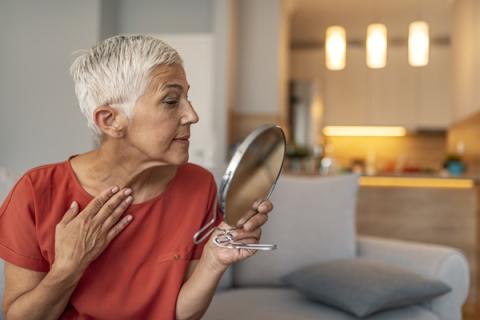Aging Skin – What to Expect, What’s Normal and What’s Not
Normal changes in aging skin
- Thinning, more transparent skin: As we age, less collagen and elasticity makes skin thinner and more fragile, which can lead to skin tears.
- Dryness and itchiness: This is usually caused by dehydration, improper nutrition, or climate-related conditions. The skin also produces less oil as we age, which can contribute to dryness.
- Age spots: Sun exposure over the years can lead to dark spots on the skin.
- Bruising: Thinner blood vessel walls and medications such as anticoagulants can result in easier bruising.
- Skin tags: These are harmless growths that often develop in areas where skin rubs against skin, clothing, or jewelry.
- Loss of fat under the skin: This can result in looser skin and a leaner look, especially around the face, leading to sunken eyes.
- Bone loss around the mouth and chin: This can cause the skin around the mouth to pucker.
- Cartilage loss in the nose: As cartilage diminishes, the tip of the nose may begin to droop.
Ways to help manage changes in aging skin
While many skin changes that happen due to aging can’t be simply undone, there are steps you can take to keep your skin healthy and maintain its appearance.
- Be sun smart: Protect your skin from the sun’s harmful rays by applying sunscreen, wearing protective clothing, and limiting your time in the sun.
- Quit smoking: Smoking accelerates skin aging and can lead to wrinkles.
- Avoid hot water: Opt for warm water during showers or baths to prevent drying out the skin.
- Choose mild soaps and moisturizers: These help maintain the skin’s natural moisture balance.
- Stay hydrated and maintain proper nutrition: These habits aren’t just good for overall well-being, but they contribute to healthy skin, too.
Skin changes that may indicate more serious problems
As you age, it’s important to pay attention to your skin’s condition, watch for any changes that could indicate underlying health issues, and follow up with your doctor.
- Changes in moles: If you notice that a mole is asymmetrical, has a fuzzy border, is unevenly colored, has a large diameter, is changing in size or shape, or it starts to itch or bleed, this could be an indicator of skin cancer.
- Wounds that don’t heal: Persistent wounds could indicate diabetes, circulation problems, or other medical issues.
- Red, scaly patches of skin: These could be a sign of Bowen’s Disease, which is a slow-growing form of skin cancer.
- Scaly spots or patches of skin that become hard and wartlike over time: These could be actinic keratoses, which are very common and usually the result of sun damage. However, they should be checked by a doctor to prevent them from turning into skin cancer.
Aging skin is a normal part of growing older, but regularly checking your skin for unusual changes and consulting a doctor about anything out of the ordinary can go a long way in protecting your health. By taking proactive steps and staying informed, you can maintain healthy, beautiful skin as you grow older.
